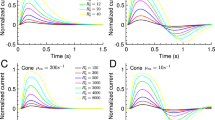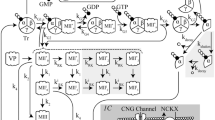Summary
The prolonged depolarizing afterpotential (PDA) is a phenomenon which is tightly linked to visual pigment conversion. In order to determine whether processes underlying PDA induction and depression can spread in space, the PDA was recorded intracellularly in white-eyedCalliphora R1-6 photoreceptors and used to examine interactions between processes induced by activating statistically different photopigment molecules (Figs. 3–6). It was found that a PDA induced by converting some fraction of rhodopsin (R) molecules forward into the metarhodopsin (M) state can be completely depressed by equal or smaller amounts of pigment conversion, backward from metarhodopsin to rhodopsin even when largely different sets of pigment molecules were shifted in the respective directions, in agreement with previous experiments conducted on the barnacle. The characteristics of the afterpotentials obtained following the cessation of strong blue and green light stimuli which did not cause a net pigment conversion was examined (Figs. 7, 8). It was found that these afterpotentials, obtained when nonet R to M conversion took place, could not be depressed by an opposite net large M to R pigment conversion. Accordingly we propose to restrict the term PDA to an afterpotential which can be depressed by a net M to R pigment conversion. It is concluded: (a) that some processes underlying PDA induction and depression inCalliphora must interact at a distance which extends at least to the nearest neighboring pigment molecule, and (b) that inCalliphora photoreceptors net pigment conversion is required in order to induce and depress a PDA.
Similar content being viewed by others
Abbreviations
- R :
-
rhodopsin
- M :
-
metarhodopsin
- R to M :
-
rhodopsin to metarhodopsin pigment conversion
- M to R :
-
metarhodopsin to rhodopsin pigment conversion
- PDA :
-
prolonged depolarizing afterpotential
- ERG :
-
electroretinogram
- M potential :
-
metarhodopsin potential
- ERP :
-
early receptor potential
References
Albani C, Nöll GN, Yoshikami S (1980) Rhodopsin regeneration, calcium, and the control of the dark current in vertebrate rods. Photochem Photobiol 32:515–520
Armon E, Minke B (1983) Light activated electrogenic Na+- Ca+2 exchange in fly photoreceptors: Modulation by Na+/ K+-pump activity. Biophys Struct Mech 9:349–357
Baumann F, Hadjilazaro B (1972) A depolarizing aftereffect of intense light in the drone visual receptor. Vision Res 12:17–31
Brown JE, Lisman JE (1972) An electrogenic sodium pump inLimulus ventral photoreceptor cells. J Gen Physiol 59:720–733
Hamdorf K (1979) The physiology of invertebrate visual pigments. In: Autrum H (ed) Handbook of sensory physiology, vol VII/6 A. Springer, Berlin Heidelberg New York, pp 145–224
Hamdorf K, Razmjoo S (1977) The prolonged depolarizing afterpotential and its contribution to the understanding of photoreceptor function. Biophys Struct Mech 3:163–170
Hamdorf K, Razmjoo S (1979) Photoconvertible pigment states and excitation inCalliphora; the induction and properties of the prolonged depolarizing afterpotential. Biophys Struct Mech 5:137–161
Hillman P, Hochstein S, Minke B (1976) Nonlocal interactions in the photoreceptor transduction process. J Gen Physiol 68:227–245
Hillman P, Hochstein S, Minke B (1983) Transduction in invertebrate photoreceptors: Role of pigment bistability. Physiol Rev 63:668–772
Hochstein S, Minke B, Hillman P (1973) Antagonistic components of the late receptor potential in the barnacle photoreceptor arising from different stages of the pigment process. J Gen Physiol 62:105–128
Ikeda K, Kaplan WD (1970) Patterned neural activity of a mutantDrosophila melanogaster. Proc Natl Acad Sci USA 66:765–772
Koike H, Brown HM, Hagiwara S (1971) Hyperpolarization of a barnacle photoreceptor membrane following illumination. J Gen Physiol 57:723–737
Larrivee DC, Conrad SK, Stephenson RS, Pak WL (1981) Mutation that selectively affects rhodopsin concentration in the peripheral photoreceptors ofDrosophila melanogaster. J Gen Physiol 78:521–545
Minke B (1979) Transduction in photoreceptors with bistable pigments: intermediate processes. Biophys Struct Mech 5:163–174
Minke B, Kirschfeld K (1979) The contribution of a sensitizing pigment to the photosensitivity spectra of fly rhodopsin and metarhodopsin. J Gen Physiol 73:517–540
Minke B, Kirschfeld K (1980) Fast electrical potentials arising from activation of metarhodopsin in the fly. J Gen Physiol 75:381–402
Pak WL, Lidington KJ (1974) Fast electrical potential from a long-lived long-wavelength photoproduct of fly visual pigment. J Gen Physiol 63:740–756
Razmjoo S, Hamdorf K (1980) In support of the ‘photopigment model’ of vision in invertebrates. J Comp Physiol 135:209–215
Stark WS, Zitzmann WG (1976) Isolation of adaptation mechanisms and photopigment spectra by vitamin A deprivation inDrosophila. J Comp Physiol 105:15–27
Stephenson RS, Pak WL (1980) Heterogenic components of a fast electrical potential inDrosophila compound eye and their relation to visual pigment photoconversion. J Gen Physiol 75:353–379
Tsukahara Y, Horridge GA (1977) Miniature potentials, light adaptation and afterpotentials in locust retinula cells. J Exp Biol 68:137–149
Tsukahara Y, Horridge GA (1978) The distribution of bumps in the tail of the locust photoreceptor afterpotential. J Exp Biol 73:1–14
Author information
Authors and Affiliations
Rights and permissions
About this article
Cite this article
Minke, B., Kirschfeld, K. Non-local interactions between light induced processes inCalliphora photoreceptors. J. Comp. Physiol. 154, 175–187 (1984). https://doi.org/10.1007/BF00604983
Accepted:
Issue Date:
DOI: https://doi.org/10.1007/BF00604983




